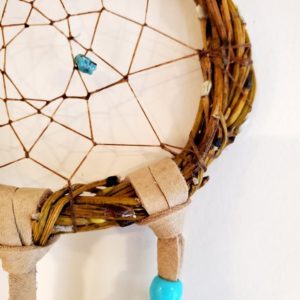Dreamcatchers
The Legend of the Dreamcatcher
Legend has it that Grandmother Spider, who sang the universe into existence, was saddened by the bad dreams of her human children. Grandmother Spider went to the wise Willow tree and asked him for his beautiful branches. She went to the powerful Eagle, the messenger of the Creator, and asked him for his powerful feathers. Grandmother Spider then bent the branches of the Willow into a circle connecting all the people and the creatures in the world. She spun her web of wisdom around the willow hoop to catch her children’s bad dreams. Grandmother Sun’s morning rays burned away the bad dreams tangled in the web, while the smaller good dreams passed through. Any bad dreams that were still left were turned into nighttime dew. These dreams trickled down the length of the feathers and were given back to Mother Earth.
Note:
Dreamcatchers originated in the Great Lakes Region. Approximately 120 bands of Native Peoples have occupied the Great Lakes basin over the course of history in the last 5 centuries. These native tribes are part of the Algonkian language family. This includes such present-day tribes as the Ojibway, Chippewa, Fox, Huron, Iroquois, Ottawa, Potawatomi, Menominee and Sioux. These where created for good luck and dream protection to be hung near a sleeping persons head. Baby’s, Elders, the sick, new homes and newlyweds where first to receive one for their unique spaces, in order to offer up the best of luck for those that displayed one.
The web is created with one continuous piece of sinew representing the circle of life unbroken and supporting a long life to live. The sinew represents “the gut” reminding us to follow our instincts whenever the time presents itself. The weave mimics the shape of a web referring to those situations and people we “weave” into our daily lives and to always be mindful of our impact of our actions and non-actions. As both have on ourselves and those around us. It is said the bad dreams were caught in the web and go directly through the center of the web and at the first sight of sunlight those bad dreams are lost forever. The good dream would gently drop down the ladder of feathers and beads, into the minds of the person below. The intention is in hopes that they might manifest in a good way, and somehow assist the persons to achieve their goals in actual daily life.
The willow hoop represents our community circle and is a reminder to bend before breaking in any difficult situation. The bead is said to be grandmother spider and a reminder to consult our Elders whenever we are in doubt, here in the dreamcatcher, she is of a protecting nature to the dreamers as they are in a vulnerable sleep state. She watches over them and directs the dreams good and bad.
Today the dreamcatcher is used by almost every culture around the world mostly because our native people where reluctantly relocated around Europe, as the colonizers took over their lands. These natives people would share their dreamcatcher teachings and creations in their new land. Unaware of the coming era of appropriation, now we see them made without the magical blessings and workings of our native aunties and grandmothers.
It is said that every dreamcatcher should be cleansed and blessed, (according to the individual tribe) often with an initial tobacco offering when harvested, sage smudging tools, beads, feathers, leathers and webbing sometimes before putting them together and finally blessed with a sweetgrass ceremony when done in order to truly be effective dream protectors. After some time the use of the dreamcatcher may force them to lose their magical effectiveness and will need to be re-smudged and blessed.
Our family are part Ojibway and Potawatomi and we make all according to the teachings and tradition we where guided by in Ontario. We use as much natural items to create these however the beads maybe plastic and although the feathers are real may be dyed and the sinew is now assimilated gut lining so also not natural. We make them with lots of love and intention and offer them up to you and your loved ones with the greatest care and kindness.
Chi Miigwech Tamare White-Wolf
Showing the single result

